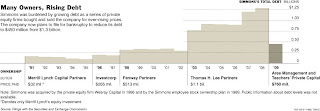Baseline Scenario compares this to breaking open a piggy bank and taking away its collections, and sums up the story of these perfectly "legal" transactions concisely and in the process points to the huge incentive distortions that bedevil the shadow banking sector,
"Thomas H. Lee Partners bought Simmons in 2003 for $327 million in real money and $745 million in debt. But that’s debt issued by Simmons, not by THL. To buy the company, they needed to pay the previous owners $1.1 billion in real money. The previous owners didn’t care where the money came from, so as long as THL could find banks or bond investors willing to lend $745 million to Simmons, the deal could go through. Since THL put up 100% of the equity in the new version of Simmons, they owned 100% of the company.
In 2004, Simmons borrowed more real money (by issuing new debt) and promptly gave $137 million of that real money to THL as a special dividend. In 2007, Simmons borrowed $300 million more in real money and paid $238 million of it to THL. So THL got $375 million in special dividends in exchange for its $327 million investment (plus an additional $28 million in fees). Simmons is now going into bankruptcy, unable to pay off all that debt, a casualty of the collapse in the housing market (houses => beds).
Now, there’s nothing illegal about this. If I own 100% of the equity in something, I can do whatever I want with it (subject to any covenants imposed by lenders). Since THL was the sole shareholder in Simmons, it was perfectly justified in pulling cash out of the corporate treasury, and I’m sure it told Simmons’s creditors that this is precisely what it was going to do with the 2004 and 2007 bond proceeds. They were just maximizing value to the shareholders — themselves. And they did it using their core competency — at every chance they got, they prettied the company up for the debt markets and convinced investors to lend it even more money."

In other words, THL "loaded up on the debt and pay yourself off". The results is that even as Simmons is set to file for bankruptcy after having laid-off 1000 employees (a quarter of its workforce) and lost more than $575 mn for its bondholders, THL has pocketed around $77 million in profit, collected millions of dollars in the form of special dividends, and paid itself millions more in fees, first for buying the company, then for helping run it.
See also Yves Simth and this excellent paper by George Akerlof and Paul Romer (also here), which foresaw precisely such situations when limited liability corporations can borrow money, pay it into the private account of the owner, and then default on its debt.
Of even greater concern is that if Simmons or its creditors are "too big to fail", then those reckless creditors and managers will be bailed out. Heads I win, tails you lose!
No comments:
Post a Comment